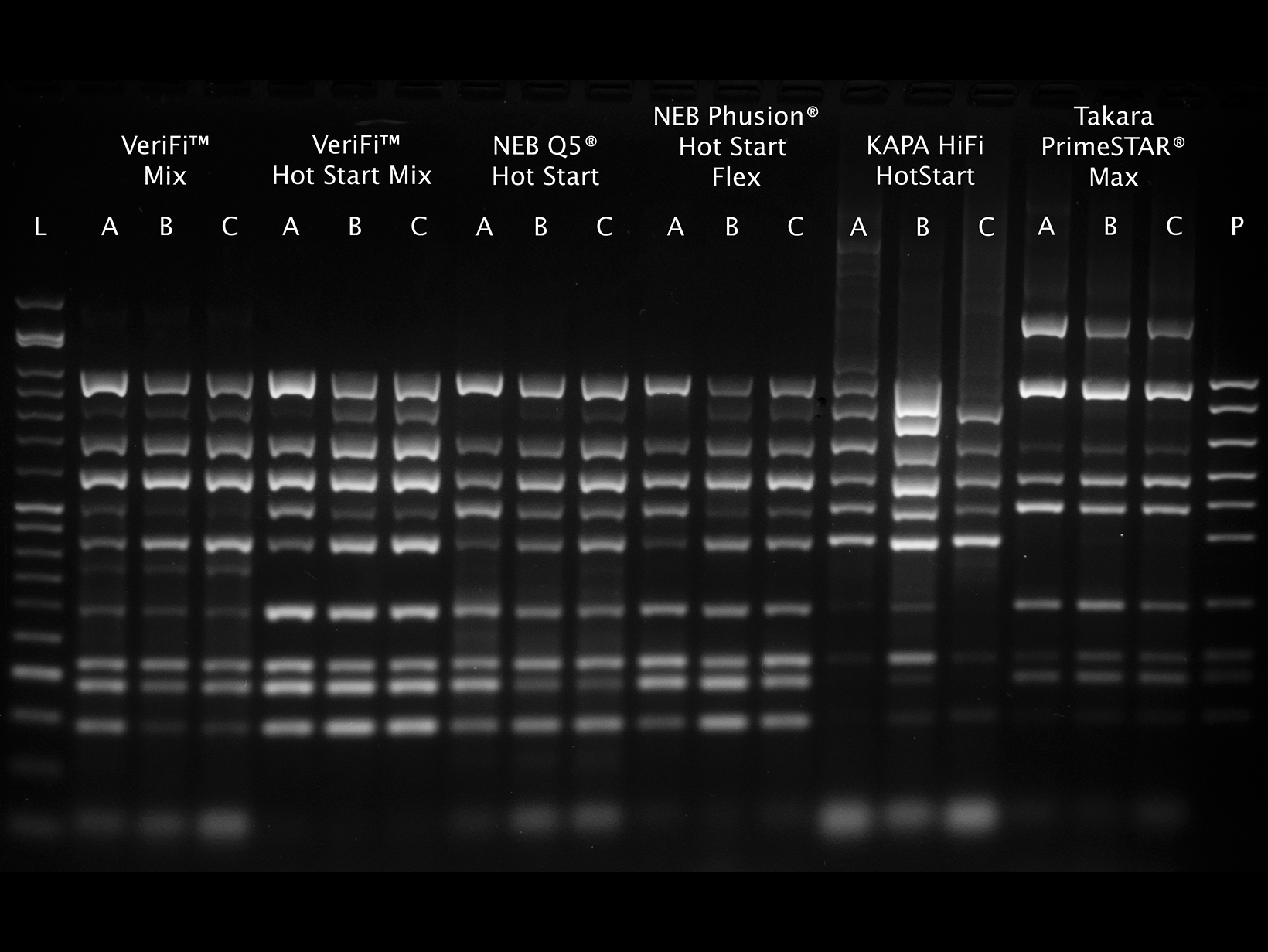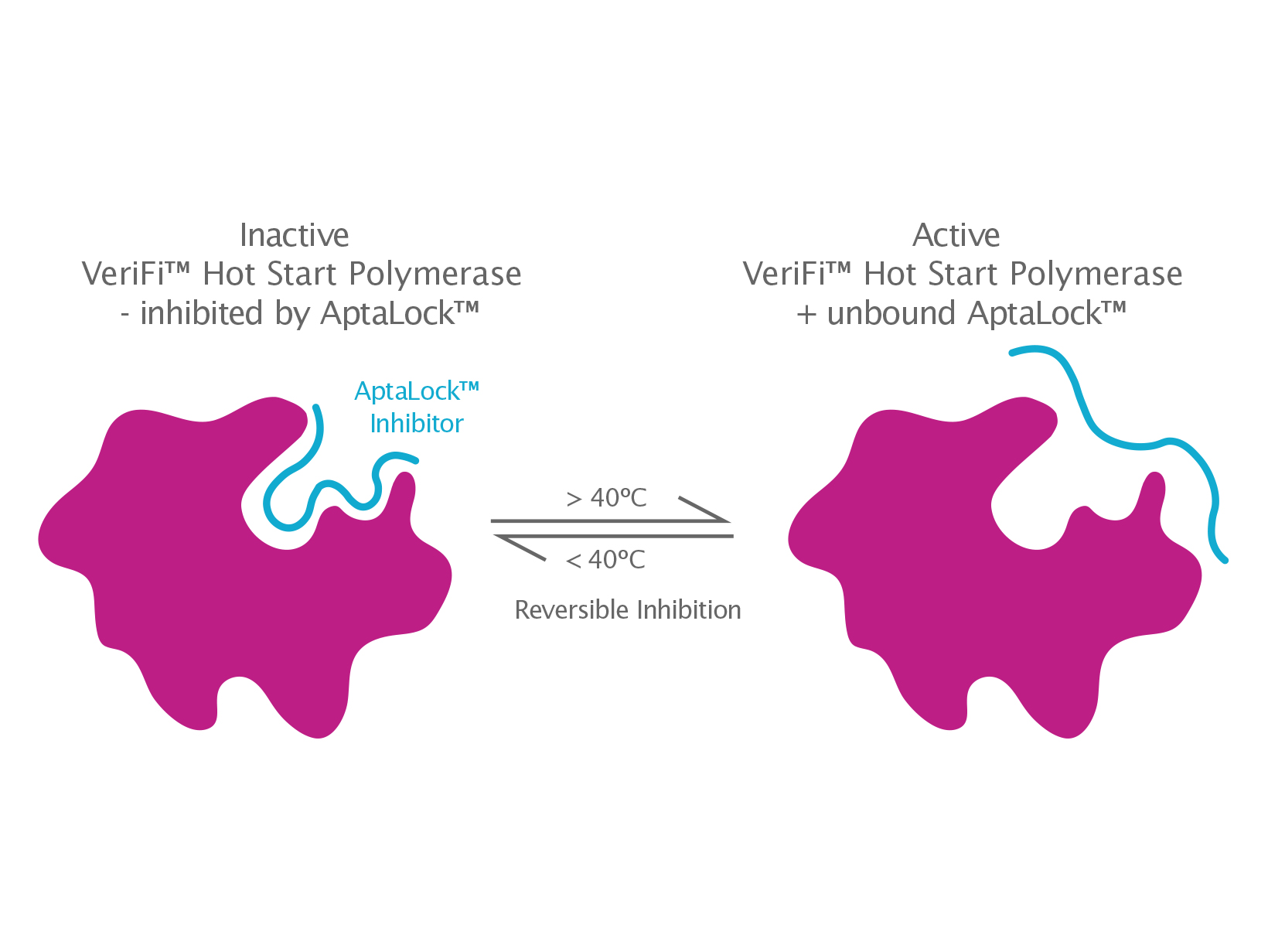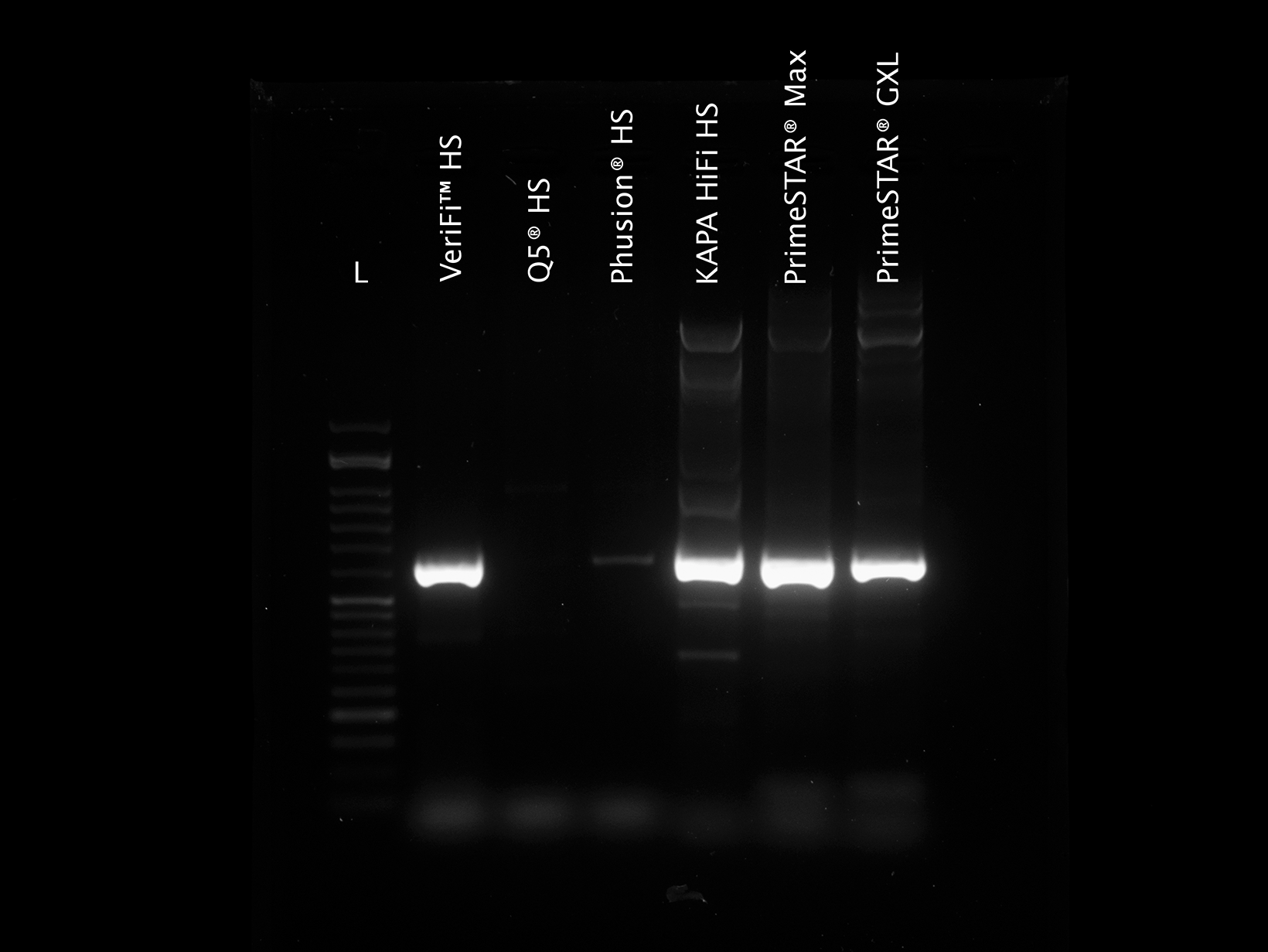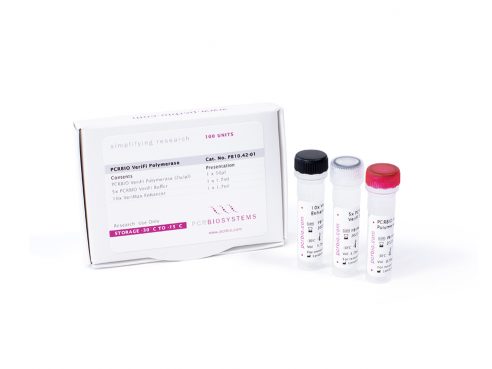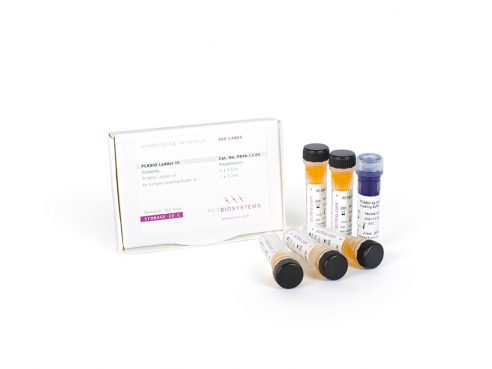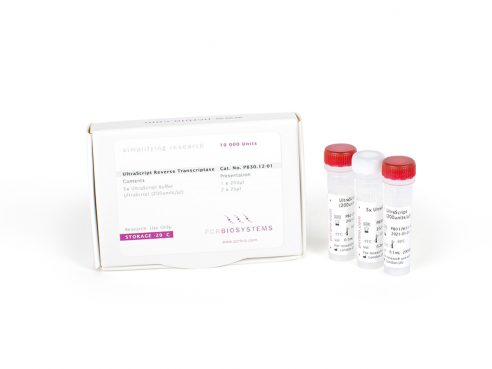To view your price please login or contact us
VeriFi™ Hot Start Polymerase & Mixes
VeriFi™ Hot Start Polymerase is a versatile and robust proofreading enzyme with AptaLock™ hot start technology for highly precise PCR.
Improved DNA binding and increased processivity give significant improvements in speed, yield and sensitivity while also increasing PCR success rates of long and challenging templates.
VeriFi™ Hot Start Polymerase was formerly known as PCRBIO HS VeriFi™ Polymerase
Features
- AptaLock™ hot start technology for maximised sensitivity and specificity
- Greater success with long and/or GC or AT-rich templates (17.5 kb and over)
- High temperature cycling – up to 100°C denaturation to better separate GC-rich sequences
- 100x higher fidelity than Taq DNA polymerase
- Room temperature setup
- Reaction mix stability for up to 24 hours both before and after PCR run
- Generates blunt-end PCR products
- Also available as a 2x ready mix with the option of a red dye for direct gel loading
More Information
VeriFi™ Hot Start Polymerase is a single enzyme derived from Pfu DNA polymerase for its 3’-5’ exonuclease (proofreading) activity. Proprietary mutations improve DNA binding and increase processivity when compared to its native form, resulting in shorter extension times, higher yields and the ability to amplify longer and more difficult targets. VeriFi™ Hot Start Polymerase is able to amplify eukaryotic genomic templates in excess of 17.5 kb, and longer for simpler DNA templates. Extension times of 30 s per kb are recommended for most applications.
PCRBIO’s innovative AptaLock™ technology uses a proprietary aptamer-like molecule that reversibly inhibits both the 3’-5’ exonuclease activity and 5’-3’ polymerase activity of the enzyme below 40°C. This unique hot start molecule prevents primer dimer formation and non-specific amplification to maximise the sensitivity and specificity of your PCR. This feature makes VeriFi™ Hot Start Polymerase highly suitable for multiplexing and enables reactions to be set up at room temperature. The reaction mix is stable both before and after the PCR run for up to 24 hours, meaning greater ease of use for high throughput assays.
The enhanced accuracy of VeriFi™ Hot Start Polymerase gives extremely low error rates and fidelity that is approximately 100 times higher than Taq DNA polymerase. The enzyme is ideal for applications where superior accuracy is required, such as cloning, site-directed mutagenesis and sequencing.
The enzyme is provided with an advanced buffer system including dNTPs, Mg and enhancers, enabling high fidelity PCR of a wide range of targets and fragment sizes regardless of GC or AT content. For the most difficult templates, such as highly GC-rich sequences or those with complex secondary structures, users have the option of adding the VeriMax Enhancer to the reaction mix for improved PCR performance.
VeriFi™ Hot Start Polymerase is also available as a convenient 2x ready mix containing all reaction components apart from primers and template. Our 2x red mix contains a red dye suitable for direct loading and tracking during agarose gel electrophoresis.
Applications
- High fidelity PCR
- Long PCR
- Multiplex and high throughput PCR
- Site-directed mutagenesis
- Cloning
- Sequencing
Specifications
VeriFi™ Hot Start Polymerase
Component
100 Units
500 Units
VeriFi™ Hot Start Polymerase (2 U/μL)
1 x 50 μL
1 x 250 μL
5x VeriFi™ Buffer
1 x 1.7 mL
3 x 1.7 mL
10x VeriMax Enhancer
1 x 1.7 mL
2 x 1.7 mL
PCRBIO HS VeriFi™ Mix
Component
100 Reactions
500 Reactions
2x VeriFi™ Hot Start Mix
2 x 1.25 mL
10 x 1.25 mL
PCRBIO HS VeriFi™ Mix Red
Component
100 Reactions
500 Reactions
2x VeriFi™ Hot Start Mix Red
2 x 1.25 mL
10 x 1.25 mL
VeriFi™ Hot Start Polymerase
Component
VeriFi™ Hot Start Polymerase (2 U/μL)
5x VeriFi™ Buffer
10x VeriMax Enhancer
100 Units
1 x 50 μL
1 x 1.7 mL
1 x 1.7 mL
500 Units
1 x 250 μL
3 x 1.7 mL
2 x 1.7 mL
PCRBIO HS VeriFi™ Mix
Component
2x VeriFi™ Hot Start Mix
100 Reactions
2 x 1.25 mL
500 Reactions
10 x 1.25 mL
PCRBIO HS VeriFi™ Mix Red
Component
2x VeriFi™ Hot Start Mix Red
100 Reactions
2 x 1.25 mL
500 Reactions
10 x 1.25 mL
Reaction Volume
Storage
50 μL
On arrival, products should be stored between -30 and -15°C. If stored correctly the kit will retain full activity for 12 months.
Reaction Volume
50 μL
Storage
On arrival, products should be stored between -30 and -15°C. If stored correctly the kit will retain full activity for 12 months.
Documents
Product Flyers
Product Manuals
Material Safety Data Sheets
Certificate of Analysis Finder
FAQs
Can I use VeriFi™ Hot Start Polymerase if my assay requires a specialised buffer?
The 5x VeriFi™ buffer supplied with VeriFi™ Hot Start Polymerase has been developed specifically for this enzyme and we highly recommend using them together. However, VeriFi™ Hot Start Polymerase should be compatible with any PCR buffer developed for use with Pfu polymerase. If you use a customised buffer with VeriFi™ Hot Start Polymerase, keep in mind that reaction parameters such as annealing temperature and concentrations of enzyme, template, dNTPs and MgCl2, may require optimisation.
Can VeriFi™ Hot Start Polymerase be used for colony PCR?
Yes. If you’re working from bacterial colonies, use a sterile tip to pick a colony and resuspend into the 50 µL PCR reaction. If working from liquid culture add 5 µL of overnight culture to the final mix. Follow the general protocol and increase the initial denaturation time to 10 min at 95 °C.
Can VeriFi™ Hot Start Polymerase be used for Multiplex PCR?
VeriFi™ Hot Start Polymerase contains the innovative AptaLock™ technology which minimises unwanted reactivity at room temperature and makes this product suitable for multiplexing.
When first performing multiplex PCR, we recommend running an annealing temperature gradient from 55 °C to 65 °C. The annealing temperature that results in the best specificity should be used in subsequent experiments.
The optimal extension time for multiplex reactions will be dependent on the complexity of template, the length of amplicons, and the number of targets. We recommend starting with the extension time of the longest fragment, and then increasing in increments of between 10 and 30 seconds if necessary. For example, for the multiplex reaction shown on the website (10-plex with fragments from 139 bp and 962 bp), a 90 second extension time was used.
Fast cycling conditions should not be used for multiplex PCR.
Thanks to AptaLock™ hot start technology, there is no need to set up reactions on ice or cooling blocks from start till finish. Primers must be designed carefully to avoid overlapping sequences as much as possible while maintaining diverse amplicon lengths that can be easily analysed with your end-detection method1-3.
1 Markoulatos, P., Siafakas, N. & Moncany, M. Multiplex polymerase chain reaction: a practical approach. J Clin Lab Anal 16, 47-51, doi:10.1002/jcla.2058 (2002).
2 Radhika, M., Saugata, M., Murali, H. S. & Batra, H. V. A novel multiplex PCR for the simultaneous detection of Salmonella enterica and Shigella species. Brazilian Journal of Microbiology 45, 667-676, doi:10.1590/s1517-83822014005000041 (2014).
3 Perez-Perez, F. J. & Hanson, N. D. Detection of plasmid-mediated AmpC beta-lactamase genes in clinical isolates by using multiplex PCR. J Clin Microbiol 40, 2153-2162, doi:10.1128/jcm.40.6.2153-2162.2002 (2002).
My results contain a high background of non-specific amplicons or smears. What troubleshooting suggestions do you have?
If smears are a concern, it’s good practice to ensure they are not an artifact of running agarose gel electrophoresis with sub optimal conditions. Sub optimal conditions can include high voltage or not allowing enough time for the gel to set etc1.
You may also need to troubleshoot the PCR reaction. If this is the case, consider the suggestions and literature below2:
- Primers should be designed to prevent primer-primer interactions and improve specificity.
- Increase the annealing temperature or conducting an annealing temperature gradient PCR to determine the optimal annealing temperature.
- Reduce the amount of template in the reaction. For high quality DNA, use 1–100 ng genomic DNA or ≤5 ng plasmid/lambda DNA per 50 µL reaction.
- Reduce the number of cycles.
- Reduce the amount of enzyme per reaction.
- Reduce the primer concentration, but not lower than 100 nM of each primer.
- Add 10x VeriMax Enhancer.
- Include DMSO in the reaction to a final concentration of 5%–10%.
1 Koontz, L. Agarose Gel Electrophoresis. Laboratory methods in enzymology : DNA. First edition. edn, Vol. 529 35-45 (2013).
2 Lorenz, T. C. Polymerase chain reaction: basic protocol plus troubleshooting and optimization strategies. J Vis Exp, e3998, doi:10.3791/3998 (2012).
My results show a very low yield. What trouble-shooting suggestions do you have?
You may want to consider the suggestions below and also refer to the literature1.
- Optimise the annealing temperature in an annealing temperature gradient PCR.
- Increase the amount of template in the reaction.
- Increase the number of cycles.
- Increase the amount of enzyme per reaction.
- Increase the primer concentration, but do not exceed 1 µM of each primer.
- Try a fresh dNTP solution.
- Optimise the MgCl2 concentration.
- Add 10x VeriMax Enhancer.
1 Lorenz, T. C. Polymerase chain reaction: basic protocol plus troubleshooting and optimization strategies. J Vis Exp, e3998, doi:10.3791/3998 (2012).
The high GC content in my DNA is causing low yields of PCR product. What is the optimal denaturation temperature and time for VeriFi™ Hot Start Polymerase in this case?
If you’re working with GC-rich DNA and finding the yield of your PCR product is too low, try increasing the denaturation temperature to 98-100 °C. VeriFi™ Hot Start Polymerase is capable of withstanding these temperatures and has shown increased yields for DNA with high GC content relative to denaturation at 95 °C. The denaturation time can be varied from 10 seconds up to 30 seconds if required.
Addition of 10x VeriMax Enhancer can also help to amplify GC-rich targets.
What are the differences between the different formats of VeriFi™ Hot Start Polymerase?
VeriFi™ Hot Start Polymerase is available in three formats. One format contains the enzyme (2 U/µL) with a separate 5x VeriFi™ buffer and a separate 10x VeriMax Enhancer tube. The other format contains the enzyme, buffer and enhancer conveniently premixed as a 2x mix. Additionally, the 2x mix is also available with a red dye giving further convenience for direct loading and tracking during agarose gel electrophoresis. All of our formats contain the required reaction components for PCR except for primers, template and PCR grade water.
What is the apparent Mw of the Red Mix dye on agarose gels?
This non-inhibitory dye, added to enable direct gel loading, runs at a similar rate to 200-300 bp DNA fragments on a 1% agarose gel and at 50-100 bp on a 2% agarose gel. You may notice a shift in this apparent molecular weight when running gels of different agarose content.
What is AptaLock™ technology?
AptaLock™ is an innovative proprietary technology that uses an aptamer-like molecule to confer hot start activity to the polymerase. It is an alternative method to antibody-mediated hot start. The AptaLock™ molecule reversibly binds and inhibits the 3′-5′ exonuclease and 5′-3′ polymerase activities of the enzyme at temperatures below 40°C. This allows the reaction to be set up at room temperature without the loss of sensitivity and specificity as a result of primer dimer formation and non-specific amplification.
What is the difference between VeriFi™ Hot Start Polymerase and VeriFi™ Polymerase / PCRBIO HiFi Polymerase?
VeriFi™ Hot Start Polymerase is the hot start version of VeriFi™ Polymerase, and uses PCR Biosystems’ innovative AptaLock™ technology for increased sensitivity and specificity compared to the two non hot start enzymes. Reactions can also be set up at room temperature when using VeriFi™ Hot Start Polymerase.
Both VeriFi™ Hot Start Polymerase and VeriFi™ Polymerase have an enhanced processivity relative to PCRBIO HiFi Polymerase, resulting in higher yields and the ability to amplify longer (up to 17.5 kb) and more difficult targets. Both enzymes also have a higher fidelity than PCRBIO HiFi Polymerase.
Unlike PCRBIO HiFi polymerase, the VeriFi™ family of enzymes are also available as convenient 2x ready mixes with the option of a red dye for direct gel loading.
What is the fidelity of PCRBIO HS VeriFi™ Polymerase relative to wild-type Taq DNA Polymerase?
VeriFi™ Hot Start Polymerase has a very low error rate, with a fidelity approximately 100 times higher than wild-type Taq DNA polymerase.
What is the recommended extension time for PCRBIO HS VeriFi™ Polymerase?
30 seconds per kilobase (kb) is recommended for amplification from eukaryotic DNA. In case the yield is lower than expected, this time could be increased to 40 sec/kb. We would not recommend decreasing the extension time to less than 30 sec/kb as this would significantly decrease the yield of product formation. Care should be taken in not loading too much template DNA. If there are non-specific bands present after amplification the amount of template DNA should be decreased. 2-step protocols which combine annealing and extension are also possible. Optimisation of the cycling conditions and template concentration may be required if you deviate from the conditions and concentration recommended in the manual.
What type of cloning strategy should I use with a fragment generated using PCRBIO HS VeriFi™ polymerase?
PCR products generated by VeriFi™ Hot Start Polymerase have blunt ends, making them suitable for blunt end cloning without requiring any further modification.
If you would like to add A-overhangs, you can use Taq DNA Polymerase or Klenow (exo-) DNA followed by TA cloning1. Before proceeding with the addition of A-overhangs, ensure the VeriFi™ Hot Start Polymerase has been removed from the reaction. If there is any VeriFi™ Hot Start Polymerase present, the 3’-5’ exonuclease activity of the enzyme can remove A-overhangs.
1 Yao, S., Hart, D. J. & An, Y. Recent advances in universal TA cloning methods for use in function studies. Protein Eng Des Sel, doi:10.1093/protein/gzw047 (2016).
When should I use the 10x VeriMax Enhancer?
In situations where low yields or no amplification is observed, we recommend adding the 10x VeriMax Enhancer to the reaction mix. This enhancer can improve the performance of VeriFi™ Hot Start Polymerase on some difficult or long templates, for example GC-rich templates or those with complex secondary structures.
More Information
VeriFi™ Hot Start Polymerase is a single enzyme derived from Pfu DNA polymerase for its 3’-5’ exonuclease (proofreading) activity. Proprietary mutations improve DNA binding and increase processivity when compared to its native form, resulting in shorter extension times, higher yields and the ability to amplify longer and more difficult targets. VeriFi™ Hot Start Polymerase is able to amplify eukaryotic genomic templates in excess of 17.5 kb, and longer for simpler DNA templates. Extension times of 30 s per kb are recommended for most applications.
PCRBIO’s innovative AptaLock™ technology uses a proprietary aptamer-like molecule that reversibly inhibits both the 3’-5’ exonuclease activity and 5’-3’ polymerase activity of the enzyme below 40°C. This unique hot start molecule prevents primer dimer formation and non-specific amplification to maximise the sensitivity and specificity of your PCR. This feature makes VeriFi™ Hot Start Polymerase highly suitable for multiplexing and enables reactions to be set up at room temperature. The reaction mix is stable both before and after the PCR run for up to 24 hours, meaning greater ease of use for high throughput assays.
The enhanced accuracy of VeriFi™ Hot Start Polymerase gives extremely low error rates and fidelity that is approximately 100 times higher than Taq DNA polymerase. The enzyme is ideal for applications where superior accuracy is required, such as cloning, site-directed mutagenesis and sequencing.
The enzyme is provided with an advanced buffer system including dNTPs, Mg and enhancers, enabling high fidelity PCR of a wide range of targets and fragment sizes regardless of GC or AT content. For the most difficult templates, such as highly GC-rich sequences or those with complex secondary structures, users have the option of adding the VeriMax Enhancer to the reaction mix for improved PCR performance.
VeriFi™ Hot Start Polymerase is also available as a convenient 2x ready mix containing all reaction components apart from primers and template. Our 2x red mix contains a red dye suitable for direct loading and tracking during agarose gel electrophoresis.
Applications
- High fidelity PCR
- Long PCR
- Multiplex and high throughput PCR
- Site-directed mutagenesis
- Cloning
- Sequencing
Specifications
VeriFi™ Hot Start Polymerase
Component
100 Units
500 Units
VeriFi™ Hot Start Polymerase (2 U/μL)
1 x 50 μL
1 x 250 μL
5x VeriFi™ Buffer
1 x 1.7 mL
3 x 1.7 mL
10x VeriMax Enhancer
1 x 1.7 mL
2 x 1.7 mL
PCRBIO HS VeriFi™ Mix
Component
100 Reactions
500 Reactions
2x VeriFi™ Hot Start Mix
2 x 1.25 mL
10 x 1.25 mL
PCRBIO HS VeriFi™ Mix Red
Component
100 Reactions
500 Reactions
2x VeriFi™ Hot Start Mix Red
2 x 1.25 mL
10 x 1.25 mL
VeriFi™ Hot Start Polymerase
Component
VeriFi™ Hot Start Polymerase (2 U/μL)
5x VeriFi™ Buffer
10x VeriMax Enhancer
100 Units
1 x 50 μL
1 x 1.7 mL
1 x 1.7 mL
500 Units
1 x 250 μL
3 x 1.7 mL
2 x 1.7 mL
PCRBIO HS VeriFi™ Mix
Component
2x VeriFi™ Hot Start Mix
100 Reactions
2 x 1.25 mL
500 Reactions
10 x 1.25 mL
PCRBIO HS VeriFi™ Mix Red
Component
2x VeriFi™ Hot Start Mix Red
100 Reactions
2 x 1.25 mL
500 Reactions
10 x 1.25 mL
Reaction Volume
Storage
50 μL
On arrival, products should be stored between -30 and -15°C. If stored correctly the kit will retain full activity for 12 months.
Reaction Volume
50 μL
Storage
On arrival, products should be stored between -30 and -15°C. If stored correctly the kit will retain full activity for 12 months.
Documents
Product Flyers
Product Manuals
Material Safety Data Sheets
Certificate of Analysis Finder
FAQs
Can I use VeriFi™ Hot Start Polymerase if my assay requires a specialised buffer?
The 5x VeriFi™ buffer supplied with VeriFi™ Hot Start Polymerase has been developed specifically for this enzyme and we highly recommend using them together. However, VeriFi™ Hot Start Polymerase should be compatible with any PCR buffer developed for use with Pfu polymerase. If you use a customised buffer with VeriFi™ Hot Start Polymerase, keep in mind that reaction parameters such as annealing temperature and concentrations of enzyme, template, dNTPs and MgCl2, may require optimisation.
Can VeriFi™ Hot Start Polymerase be used for colony PCR?
Yes. If you’re working from bacterial colonies, use a sterile tip to pick a colony and resuspend into the 50 µL PCR reaction. If working from liquid culture add 5 µL of overnight culture to the final mix. Follow the general protocol and increase the initial denaturation time to 10 min at 95 °C.
Can VeriFi™ Hot Start Polymerase be used for Multiplex PCR?
VeriFi™ Hot Start Polymerase contains the innovative AptaLock™ technology which minimises unwanted reactivity at room temperature and makes this product suitable for multiplexing.
When first performing multiplex PCR, we recommend running an annealing temperature gradient from 55 °C to 65 °C. The annealing temperature that results in the best specificity should be used in subsequent experiments.
The optimal extension time for multiplex reactions will be dependent on the complexity of template, the length of amplicons, and the number of targets. We recommend starting with the extension time of the longest fragment, and then increasing in increments of between 10 and 30 seconds if necessary. For example, for the multiplex reaction shown on the website (10-plex with fragments from 139 bp and 962 bp), a 90 second extension time was used.
Fast cycling conditions should not be used for multiplex PCR.
Thanks to AptaLock™ hot start technology, there is no need to set up reactions on ice or cooling blocks from start till finish. Primers must be designed carefully to avoid overlapping sequences as much as possible while maintaining diverse amplicon lengths that can be easily analysed with your end-detection method1-3.
1 Markoulatos, P., Siafakas, N. & Moncany, M. Multiplex polymerase chain reaction: a practical approach. J Clin Lab Anal 16, 47-51, doi:10.1002/jcla.2058 (2002).
2 Radhika, M., Saugata, M., Murali, H. S. & Batra, H. V. A novel multiplex PCR for the simultaneous detection of Salmonella enterica and Shigella species. Brazilian Journal of Microbiology 45, 667-676, doi:10.1590/s1517-83822014005000041 (2014).
3 Perez-Perez, F. J. & Hanson, N. D. Detection of plasmid-mediated AmpC beta-lactamase genes in clinical isolates by using multiplex PCR. J Clin Microbiol 40, 2153-2162, doi:10.1128/jcm.40.6.2153-2162.2002 (2002).
My results contain a high background of non-specific amplicons or smears. What troubleshooting suggestions do you have?
If smears are a concern, it’s good practice to ensure they are not an artifact of running agarose gel electrophoresis with sub optimal conditions. Sub optimal conditions can include high voltage or not allowing enough time for the gel to set etc1.
You may also need to troubleshoot the PCR reaction. If this is the case, consider the suggestions and literature below2:
- Primers should be designed to prevent primer-primer interactions and improve specificity.
- Increase the annealing temperature or conducting an annealing temperature gradient PCR to determine the optimal annealing temperature.
- Reduce the amount of template in the reaction. For high quality DNA, use 1–100 ng genomic DNA or ≤5 ng plasmid/lambda DNA per 50 µL reaction.
- Reduce the number of cycles.
- Reduce the amount of enzyme per reaction.
- Reduce the primer concentration, but not lower than 100 nM of each primer.
- Add 10x VeriMax Enhancer.
- Include DMSO in the reaction to a final concentration of 5%–10%.
1 Koontz, L. Agarose Gel Electrophoresis. Laboratory methods in enzymology : DNA. First edition. edn, Vol. 529 35-45 (2013).
2 Lorenz, T. C. Polymerase chain reaction: basic protocol plus troubleshooting and optimization strategies. J Vis Exp, e3998, doi:10.3791/3998 (2012).
My results show a very low yield. What trouble-shooting suggestions do you have?
You may want to consider the suggestions below and also refer to the literature1.
- Optimise the annealing temperature in an annealing temperature gradient PCR.
- Increase the amount of template in the reaction.
- Increase the number of cycles.
- Increase the amount of enzyme per reaction.
- Increase the primer concentration, but do not exceed 1 µM of each primer.
- Try a fresh dNTP solution.
- Optimise the MgCl2 concentration.
- Add 10x VeriMax Enhancer.
1 Lorenz, T. C. Polymerase chain reaction: basic protocol plus troubleshooting and optimization strategies. J Vis Exp, e3998, doi:10.3791/3998 (2012).
The high GC content in my DNA is causing low yields of PCR product. What is the optimal denaturation temperature and time for VeriFi™ Hot Start Polymerase in this case?
If you’re working with GC-rich DNA and finding the yield of your PCR product is too low, try increasing the denaturation temperature to 98-100 °C. VeriFi™ Hot Start Polymerase is capable of withstanding these temperatures and has shown increased yields for DNA with high GC content relative to denaturation at 95 °C. The denaturation time can be varied from 10 seconds up to 30 seconds if required.
Addition of 10x VeriMax Enhancer can also help to amplify GC-rich targets.
What are the differences between the different formats of VeriFi™ Hot Start Polymerase?
VeriFi™ Hot Start Polymerase is available in three formats. One format contains the enzyme (2 U/µL) with a separate 5x VeriFi™ buffer and a separate 10x VeriMax Enhancer tube. The other format contains the enzyme, buffer and enhancer conveniently premixed as a 2x mix. Additionally, the 2x mix is also available with a red dye giving further convenience for direct loading and tracking during agarose gel electrophoresis. All of our formats contain the required reaction components for PCR except for primers, template and PCR grade water.
What is the apparent Mw of the Red Mix dye on agarose gels?
This non-inhibitory dye, added to enable direct gel loading, runs at a similar rate to 200-300 bp DNA fragments on a 1% agarose gel and at 50-100 bp on a 2% agarose gel. You may notice a shift in this apparent molecular weight when running gels of different agarose content.
What is AptaLock™ technology?
AptaLock™ is an innovative proprietary technology that uses an aptamer-like molecule to confer hot start activity to the polymerase. It is an alternative method to antibody-mediated hot start. The AptaLock™ molecule reversibly binds and inhibits the 3′-5′ exonuclease and 5′-3′ polymerase activities of the enzyme at temperatures below 40°C. This allows the reaction to be set up at room temperature without the loss of sensitivity and specificity as a result of primer dimer formation and non-specific amplification.
What is the difference between VeriFi™ Hot Start Polymerase and VeriFi™ Polymerase / PCRBIO HiFi Polymerase?
VeriFi™ Hot Start Polymerase is the hot start version of VeriFi™ Polymerase, and uses PCR Biosystems’ innovative AptaLock™ technology for increased sensitivity and specificity compared to the two non hot start enzymes. Reactions can also be set up at room temperature when using VeriFi™ Hot Start Polymerase.
Both VeriFi™ Hot Start Polymerase and VeriFi™ Polymerase have an enhanced processivity relative to PCRBIO HiFi Polymerase, resulting in higher yields and the ability to amplify longer (up to 17.5 kb) and more difficult targets. Both enzymes also have a higher fidelity than PCRBIO HiFi Polymerase.
Unlike PCRBIO HiFi polymerase, the VeriFi™ family of enzymes are also available as convenient 2x ready mixes with the option of a red dye for direct gel loading.
What is the fidelity of PCRBIO HS VeriFi™ Polymerase relative to wild-type Taq DNA Polymerase?
VeriFi™ Hot Start Polymerase has a very low error rate, with a fidelity approximately 100 times higher than wild-type Taq DNA polymerase.
What is the recommended extension time for PCRBIO HS VeriFi™ Polymerase?
30 seconds per kilobase (kb) is recommended for amplification from eukaryotic DNA. In case the yield is lower than expected, this time could be increased to 40 sec/kb. We would not recommend decreasing the extension time to less than 30 sec/kb as this would significantly decrease the yield of product formation. Care should be taken in not loading too much template DNA. If there are non-specific bands present after amplification the amount of template DNA should be decreased. 2-step protocols which combine annealing and extension are also possible. Optimisation of the cycling conditions and template concentration may be required if you deviate from the conditions and concentration recommended in the manual.
What type of cloning strategy should I use with a fragment generated using PCRBIO HS VeriFi™ polymerase?
PCR products generated by VeriFi™ Hot Start Polymerase have blunt ends, making them suitable for blunt end cloning without requiring any further modification.
If you would like to add A-overhangs, you can use Taq DNA Polymerase or Klenow (exo-) DNA followed by TA cloning1. Before proceeding with the addition of A-overhangs, ensure the VeriFi™ Hot Start Polymerase has been removed from the reaction. If there is any VeriFi™ Hot Start Polymerase present, the 3’-5’ exonuclease activity of the enzyme can remove A-overhangs.
1 Yao, S., Hart, D. J. & An, Y. Recent advances in universal TA cloning methods for use in function studies. Protein Eng Des Sel, doi:10.1093/protein/gzw047 (2016).
When should I use the 10x VeriMax Enhancer?
In situations where low yields or no amplification is observed, we recommend adding the 10x VeriMax Enhancer to the reaction mix. This enhancer can improve the performance of VeriFi™ Hot Start Polymerase on some difficult or long templates, for example GC-rich templates or those with complex secondary structures.





